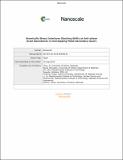Atomically sharp interlayer stacking shifts at anti-phase grain boundaries in overlapping MoS<sub>2</sub> secondary layers
Author(s)
Zhou, Si; Wang, Shanshan; Shi, Zhe; Sawada, Hidetaka; Kirkland, Angus I.; Li, Ju; Warner, Jamie H.; ... Show more Show less
DownloadAccepted version (3.234Mb)
Open Access Policy
Open Access Policy
Creative Commons Attribution-Noncommercial-Share Alike
Terms of use
Metadata
Show full item recordAbstract
© The Royal Society of Chemistry 2018. When secondary domains nucleate and grow on the surface of monolayer MoS2, they can extend across grain boundaries in the underlying monolayer MoS2 and form overlapping sections. We present an atomic level study of overlapping antiphase grain boundaries (GBs) in MoS2 monolayer-bilayers using aberration-corrected annular dark field scanning transmission electron microscopy. In particular we focus on the antiphase GB within a monolayer and track its propagation through an overlapping bilayer domain. We show that this leads to an atomically sharp interface between 2H and 3R interlayer stacking in the bilayer region. We have studied the micro-nanoscale "meandering" of the antiphase GB in MoS2, which shows a directional dependence on the density of 4 and 8 member ring defects, as well as sharp turning angles 90°-100° that are mediated by a special 8-member ring defect. Density functional theory has been used to explore the overlapping interlayer stacking around the antiphase GBs, confirming our experimental findings. These results show that overlapping secondary bilayer MoS2 domains cause atomic structure modification to underlying anti-phase GB sites to accommodate the van der Waals interactions.
Date issued
2018-08Department
Massachusetts Institute of Technology. Department of Materials Science and Engineering; Massachusetts Institute of Technology. Department of Nuclear Science and EngineeringJournal
Nanoscale
Publisher
Royal Society of Chemistry (RSC)
ISSN
2040-3364
2040-3372